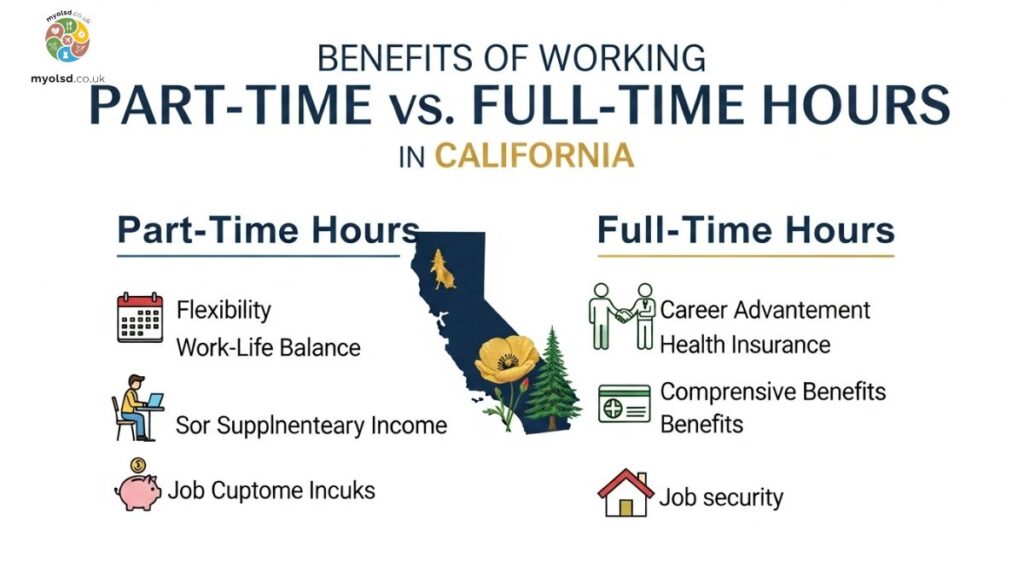Ever find yourself wondering if your part-time job really counts as part-time? Maybe you’re trying to figure out your schedule, plan your finances, or just make sense of confusing workplace rules. It’s frustrating when you hear different answers from friends, coworkers, or even online, so you’re left thinking, How many hours is part-time in California anyway?
In this post, we’ll explain everything for you. You’ll get a clear explanation of what counts as part-time work in California, the typical hour ranges, and what it means for your pay, benefits, and rights. By the end, you’ll have the answers you need to plan your work life with confidence, no more guessing or confusion.
Benefits of Working Part-Time vs. Full-Time Hours in California

Part-time work offers a level of flexibility that full-time roles often can’t match. Many people choose part-time schedules to pursue education, handle family responsibilities, or simply maintain a healthier work-life balance. In California, working part-time can mean anywhere from 16 to 32 hours per week, though some industries, like retail and food service, often schedule 20 to 29 hours per week. This flexibility allows employees to balance personal commitments while still earning a steady income.
While part-time workers may not always receive the full suite of benefits that full-time employees enjoy, California law ensures certain protections. These include minimum wage compliance, overtime eligibility under specific conditions, and rights to a safe work environment. Additionally, some employers voluntarily offer prorated benefits like health insurance, vacation pay, and retirement plan access to part-time staff. Understanding these options can help you make informed decisions about which part-time opportunities are worth pursuing.
Determining Whether to Hire Full-Time or Part-Time Employees
For employers, choosing between part-time and full-time staff depends on several factors. One important consideration is projected workloads. Businesses often examine seasonal demand, peak hours, and operational needs before determining how many part-time employees are needed. For example, a café may hire part-time staff to cover busy morning and weekend shifts, while a corporate office might prefer full-time employees for consistent daily coverage.
Budget considerations also play a significant role. Part-time employees typically cost less in benefits and payroll obligations, making them attractive for companies managing tight budgets. However, employers must still adhere to California labor laws, including minimum wage requirements and overtime regulations. Businesses also need to weigh healthcare eligibility under the Affordable Care Act (ACA), especially for employees working 30+ hours per week. Balancing cost, coverage, and flexibility ensures employers make the best staffing decisions for their specific needs.
Read more Article:How Many Curtain Panels Do I Need
Assess Projected Workloads

Evaluating workload projections can help determine whether part-time workers are sufficient. Companies often review historical data, sales trends, and staffing needs to identify peak hours requiring extra support. For instance, retail stores might hire multiple part-time employees during holiday seasons to manage customer traffic, while reducing staffing levels during slower months.
This approach allows employers to optimize labor costs without compromising service quality. Accurate workload assessments also help part-time employees plan their schedules effectively, ensuring consistent income while avoiding overwork.
Consider Your Budget
Budgeting for part-time staff requires careful planning. Employers must account for hourly wages, potential overtime, payroll taxes, and benefits if applicable. While part-time employees often save money on benefits costs, businesses still need to comply with minimum wage laws and applicable overtime rules. For example, California’s minimum wage in 2025 is $16.50 per hour, with elevated rates in cities such as San Francisco ($19.18/hour) and Los Angeles ($17.28/hour).
Balancing staffing budgets with employee needs ensures a fair and sustainable work environment. Employers should also consider potential legal risks, like misclassification of employees or failure to provide mandated benefits, which could result in penalties.
Healthcare and Overtime

Healthcare requirements under the ACA may apply to part-time employees if their combined weekly hours reach a full-time threshold (30+ hours). Companies with 50 or more full-time equivalent employees must offer health insurance, even to certain part-time staff. Employers who fail to comply can face financial penalties, so careful tracking of employee hours is essential.
Overtime pay is another key consideration. California mandates time-and-a-half pay for hours worked beyond eight per day or 40 per week for non-exempt employees. For double-time pay, any work exceeding 12 hours in a single day or eight hours on the seventh consecutive workday qualifies for increased compensation.Clear communication about these policies helps part-time staff understand their rights and plan their schedules efficiently.
Full-Time Hours in California According to the Affordable Care Act
Under the ACA, employees are regarded as full-time when they work 30 or more hours per week. While this primarily affects health insurance eligibility, it also helps distinguish between full-time and part-time roles. Part-time employees typically work fewer than 30–35 hours weekly, but thresholds can vary by company or industry.
Understanding this definition is crucial for employees navigating health coverage and benefits. Even if you work fewer than 30 hours, you may still be eligible for prorated benefits or state-specific programs like Covered California, which provides affordable healthcare options for part-time workers.
Legal Protections for Part-Time Employees in California

California labor laws ensure that part-time workers enjoy specific protections, even if they work fewer hours than full-time staff. For example, every employee must be paid at least the state minimum wage and have a safe work environment, no matter how many hours they work. Paid sick leave accrual is also guaranteed, with one hour earned for every 30 hours worked.
Workers are protected from discrimination, harassment, and retaliation, and they can access unemployment insurance if they meet the state’s earnings requirements. The California Labor Code and enforcement agencies like the DLSE and EDD oversee compliance, ensuring employers fulfill their obligations. Misclassification of employees as independent contractors can jeopardize these rights, making awareness of legal protections essential.
Minimum Wage and Hourly Thresholds
Part-time employees must be compensated according to California’s minimum wage laws. As of 2025, the statewide minimum is $16.50/hour, with variations based on city or county ordinances. For example, San Francisco and Los Angeles have higher minimum wage thresholds due to local cost-of-living considerations.
Part-time work usually falls between 16–32 hours per week, with most industries preferring 20–29 hours. Full-time employees usually work 40 hours per week, while part-time schedules offer flexibility for both employer and employee. Understanding these ranges helps workers assess pay expectations and eligibility for certain benefits.
Paid Sick Leave, Vacation, and Benefits

California requires all employers to provide part-time employees with paid sick leave, accruing at one hour per 30 hours worked. While vacation pay is not legally required for part-time workers, many employers offer prorated vacation pay based on hours worked. Benefits like health insurance and retirement contributions may also be available, depending on company policies and weekly hours.
For retirement, the Employee Retirement Income Security Act (ERISA) ensures access to employer-sponsored plans for eligible part-time staff who work 1,000+ hours in a year. Programs like CalSavers provide alternative retirement savings options if an employer doesn’t offer a 401(k). Understanding benefit eligibility can help part-time employees plan long-term financial security.
Overtime and Work Breaks
California law requires employers to provide meal breaks and rest periods for part-time employees. Employees receive a 10-minute rest break for every four hours worked and a 30-minute lunch break for shifts longer than five hours. Accurate recordkeeping of hours is essential to comply with legal requirements and ensure proper compensation.
Overtime rules apply to part-time, non-exempt employees as well. Employees receive 1.5 times their regular pay for hours over eight per day or 40 per week, and double-time pay applies for extended shifts. Understanding these regulations helps employees avoid wage disputes and ensures fair treatment under the law.
Misclassification and Employee Rights
Misclassification occurs when part-time employees are treated as independent contractors, potentially depriving them of protections like minimum wage, overtime, and paid leave. The Employment Development Department (EDD) provides guidance and investigates complaints to ensure proper classification.
Part-time employees have the right to file complaints, seek back pay, and access workplace protections. Being informed about classification rules is crucial for defending your rights and avoiding legal pitfalls.
Navigating Part-Time Hours and Employment Flexibility

Part-time work in California offers flexibility, but it also requires awareness of your legal rights and workplace policies. Whether negotiating schedules, accessing benefits, or planning career growth, understanding the intricacies of part-time employment empowers you to make better decisions.
Tracking weekly hours, knowing employer obligations, and understanding eligibility for benefits like health insurance, retirement plans, and unemployment insurance can make a big difference. By staying informed, you can maximize the advantages of part-time work while avoiding surprises related to pay or legal compliance.
FAQS
How many hours per day count as part-time in California?
Typically 3 to 6.5 hours per day, depending on weekly total.
Is 32 hours full-time in California?
No, 32 hours is generally considered part-time.
What are the legal part-time hours in California?
There isn’t a strict legal definition; typically, part-time means working under 35 to 40 hours per week.
Is 25 hours full-time in California?
No, 25 hours is considered part-time.


Good 👍